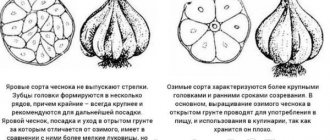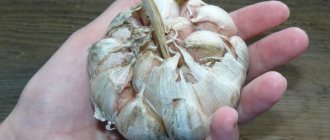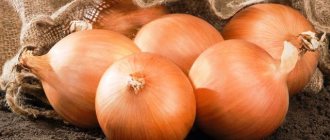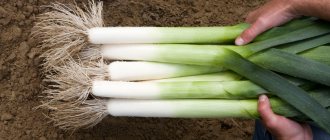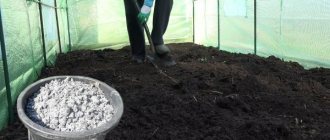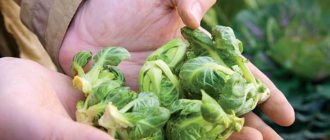Leeks are valued for their sweetish-garlic taste without bitterness, which adds piquancy to prepared dishes. The edible parts of the plant are a weak cylindrical bulb and a powerful modified stem (white leg). The green feathers of leeks are coarse and are rarely used as food.
Harvesting root crops and preparing them for storage has its own characteristics. Only fully ripened vegetables have valuable nutritional and taste qualities. A timely harvested and properly dried crop serves as a prevention of vitamin deficiency in the winter. During storage, the concentration of ascorbic acid in the leek leg and bulb increases by one and a half times.
Harvest dates
Leeks are a winter-hardy plant that easily tolerates short-term frosts without loss of commercial qualities. Harvesting should be completed before the onset of persistent cold weather. The critical thermometer reading for a plant is -5˚С, but it is safer to dig up the vegetable before the average daily temperatures drop below 0˚С. Leeks harvested in frosty weather lose their taste and cannot be stored for long.
Variety
The emergence of modern early ripening varieties has significantly expanded the growing area of crops with a long growing season. Currently, the vegetable is successfully cultivated not only in the Non-Black Earth Region, but also in the Urals, Siberia, and the Far East.
- Early ripening varieties - Vesta, Columbus, Elephant trunk ripen in the period from 90 to 130 days from the moment of emergence. Harvesting takes place from late August to early October. Root vegetables are stored for a short time; they are more suitable for seasonal consumption. Early ripening varieties are grown in regions with harsh climates.
- Mid-season varieties - Pobeditel, Kazimir, Elephant - have a more massive stem (4-8 cm in diameter) and ripen in 130-150 days. Root crops are dug up in October; after drying, the vegetables can be stored until the New Year and longer.
- Late varieties - Alligator, Autumn Giant, Karantansky - grow for 180-200 days. Root vegetables have a powerful stem and dark green foliage with a waxy coating. There is no need to rush into harvesting late-ripening leeks; it is carried out in October-November, when the mass of the edible part of the plant reaches 250-300 g. Root crops have good shelf life and are stored until spring without loss of taste.
Growing leeks in seedlings at home or in polycarbonate greenhouses reduces the ripening time of the vegetable by 3-4 weeks. This makes it possible to cultivate mid- and late-ripening varieties in areas with a cool climate.
Regions
To determine the appropriate time for harvesting leeks, you need to take into account the climatic characteristics of the region in which it is cultivated:
- Middle zone and Moscow region - the harvest is harvested in mid or late October; if the autumn turned out to be dry and warm, it is allowed to leave mid-late varieties in the beds until the beginning of November;
- Ural - mainly early varieties of leeks are grown, which are dug up in early October, before the onset of frosty weather;
- Siberia - autumn comes early, frosts are possible as early as September; the crop is harvested depending on the weather forecast from the second ten days of September to the second ten days of October;
- southern Russia - late-ripening varieties of leeks are grown, harvested from late November to early December;
- Northwestern region - root crops are harvested from the last ten days of September to mid-October, trying to complete the harvest before the onset of rainy weather.
The timing of leek harvesting is significantly influenced by weather conditions. In hot summers with short-term precipitation, the vegetable ripens 1-2 weeks earlier. Long cold spells and prolonged rains delay the harvest by 15-20 days.
Where does the miracle vegetable grow?
Until the beginning of the twentieth century, Russia did not know about the existence of a wonderful vegetable. Then it turned out: the plant is heat-loving, takes a long time to mature, but can be planted through seedlings. Now it is growing in the southern regions, the central part, and the northwestern regions. Leeks are not uncommon in Siberia. But early varieties of vegetables are cultivated there.
The vegetable ripens 3–4 months after germination. Summer residents of the south grow it through seedlings in a greenhouse. After the earth has warmed up, the feathers are placed in a permanent place.
In the central zone, gardeners have succeeded in growing vegetables: in January they sow in boxes, in February they dive. Illuminate with a phytolamp and ventilate. In April they are placed in a permanent place. Plants ripen in August-September.
In the north and northwest, gardeners plant only early varieties and hybrids. The seedling method is used. Outdoor placement time is May. The first harvest from the garden is harvested in the first ten days of September.
Some summer residents allocate a place for the onion in an unheated greenhouse. This measure allows us to solve the problem of excessive precipitation. With properly prepared soils, onion plants produce increased yields.
See also
When should you dig onions from the beds for storage? Read
The vegetable tolerates low temperatures, variable light levels, and prolonged precipitation. If the sowing time is observed, the plant will ripen in any region of gardening.
Signs of leek ripeness
Only fully ripe vegetables that contain the maximum amount of vitamins and nutrients and have good shelf life are suitable for long-term storage.
Signs of leek maturity:
- the onion feather has lost its elasticity and has shrunk slightly;
- the tips of the tops and lower leaves have turned yellow;
- the neck begins to dry out and becomes thinner;
- dry protective scales appear on the lower part of the stem and bulb, which are easily separated from the head.
The ripening period begins in accordance with the varietal characteristics, taking into account weather factors. If there are any doubts about the readiness of the vegetable, it is recommended to dig up one plant and cut the stem to assess its wateriness. When a ripe vegetable is cut, no juice is released from the stem.
When all the signs of ripeness are evident, it is better not to delay harvesting. In overripe vegetables, the foliage completely turns yellow and withers, the integumentary scales burst, and new roots form. Such leeks lose their taste and are completely unsuitable for storage.
Completely green foliage indicates the immaturity of the vegetable. To speed up the ripening of onions, it is recommended to bend the tops slightly closer to the stem. The plant's nutrition is disrupted, the foliage and neck begin to dry out faster, and there is an outflow of nutrients from the feathers to the stem.
Signs that the crop is ready for harvest
Knowing the exact planting date and growing season, you can calculate the ripening time of the crop.
However, a ripe leek can also be identified by external signs:
- a dry feather lying on the ground;
- dry neck that does not release moisture when pressed;
- dense bulb, dressed in dry scales.
These signs indicate that it is time to harvest the vegetable. In addition, the neck of a mature leek is thin and yellowish in color. Lost feathers also turn yellow. However, if the season was rainy, this feature will not appear.
How to properly dig up leeks
For the purpose of seasonal use, selective harvesting of unripe crops is allowed, which is carried out starting from the end of August. During this period, the leek leg is slightly watery, but is suitable for preparing salads, fried and baked dishes. Vegetables are removed from the garden evenly to stimulate the growth of the remaining plants, give them more space, and improve lighting.
Leeks intended for storage are dug out in one go to ensure uniform drying of the vegetable. Watering the crop is stopped 10-14 days before the expected harvest day. The harvest is harvested in sunny, dry weather; if it rains, it is recommended to wait a little before harvesting.
The event is held in the morning to allow the vegetable to dry in the fresh air. A day before harvesting, the soil is raked away from the bushes, exposing the upper part of the head. It dries slightly and becomes covered with a thin protective layer.
It is recommended to use a pitchfork to dig up leeks. A garden tool is stuck into the ground at a distance of 10 cm from the plant and the root crop is carefully lifted, lifting it above the soil surface. Then the vegetable is carefully removed from the ground.
Leeks should not be pulled out by hand while holding onto the tops. By doing this, it is easy to damage the integrity of the bulbs. To remove stuck soil, do not hit the heads against the ground or each other. Remove soil from the bulb and stem with hands wearing cotton gloves. If it is not possible to completely clean the leg, the remaining soil can be easily shaken off after the vegetable has dried.
Green feathers are not immediately trimmed - some of the nutrients from the tops pass into the stem during drying. In good weather, leeks are left to air in the beds. Vegetables are laid in one layer, having previously spread agrofibre or dense fabric on the ground. If it is going to rain, the root crops are moved under a canopy.
Preparing onions for storage
Proper harvesting will affect not only the taste of the ripe vegetable, but also the possibility of long-term storage. If harvesting rules are not followed, damage can occur within a few months, or even weeks. Interestingly, you can store not only the head of the leek, but also its feathers separately.
Important! Re-freezing leeks is strictly prohibited, as the vegetable loses its nutritional value and becomes deformed.
For long-term storage and consumption of leeks throughout the winter, follow the following preparatory steps:
- after harvesting the onion, it must be cleared of soil;
- the roots are partially trimmed so as not to damage the bulb;
- leaves should not be cut, as after this they will rapidly wither. Cut leaves are more susceptible to wilting and various diseases. Only feathers damaged during harvesting or heavily soiled should be trimmed. The cutting level of the sheet is two-thirds from the head.
How to dry leeks
If the weather is dry and sunny, vegetables are dried in the fresh air for several days. Ultraviolet light disinfects root crops and stops the development of putrefactive processes. Under the rays of the sun, protective golden scales quickly form on the stems. In autumn, nights are usually cold and there is often heavy dew. At nightfall, it is recommended to bring leeks indoors and take them back in the morning.
In rainy weather, vegetables are dried in a well-ventilated area: in the attic, in the barn or in the summer kitchen. Drying time is 10-14 days, if the onions were harvested in the rain - up to 3 weeks. Root vegetables are periodically turned over to ensure uniform drying. At the same time, sorting is carried out: vegetables with mechanical damage and thin stems are eaten or frozen.
To be rejected:
- root vegetables with cracks and signs of rot at the bottom;
- vegetables whose stems have lost elasticity and become soft during the drying process;
- bulbs with signs of mold.
The roots of the dried leek are shortened, being careful not to damage the bottom of the head with scissors (leave roots 1-1.5 cm long), the tops are shortened by one third. Only completely healthy bulbs with thick stems and intact covering scales are suitable for long-term storage. Root vegetables are sorted by size and stored separately. Smaller leeks store worse and wither faster. It is used first.
Root vegetables are best preserved in the basement at temperatures from 0 to +2˚, with an air humidity of 65%. Plants are placed vertically in boxes, covered with damp sand to a height of 7-10 cm. Small quantities of leeks are stored in the vegetable compartment of the refrigerator, on a glazed balcony or loggia.
Benefits and harms
It’s worth noting right away that leeks are several times healthier than onions and green onions. Its use allows you to get rid of a number of diseases:
- Sulfur contained in leek actively heals bones and joints.
- Active iron regulates the level of hemoglobin in the blood and resists the appearance of anemia.
- Leeks help normalize intestinal microflora.
- Normalizes cholesterol levels and fights the appearance of cholesterol plaques.
- Onions are used to prevent colds and viral diseases.
- Improves vision.
- Prevents the formation of tumors of various natures.
In addition, its diuretic properties are noted. Onions act as a natural adsorbent that can remove waste and toxins.
It is worth remembering that not everyone will benefit from the product. In case of serious diseases of the intestines and stomach, onions should not be introduced into the diet, or only in thermally processed form. You should also refrain from eating it when your sugar level is low, which it lowers even more.
Recommendations for harvesting
Experienced gardeners give advice on how to properly harvest and use leeks:
- To improve the marketability of the vegetable, it is recommended to cover the bed with an opaque film 10-15 days before harvesting. In conditions of insufficient lighting, the stem becomes white, its taste becomes more delicate and aromatic.
- Harvesting should only be done in dry weather. It is advisable that there is no rain for several days before harvesting and the soil has time to dry out. When digging up a vegetable, be careful to ensure that there is no water in the axils of the leaves. If you do not drain it, the tops will not dry out, but will rot.
- You cannot trim the green foliage of leeks in order to shorten the time for the ripeness of the vegetable. This not only does not speed up the ripening of the head, but also increases the risk of infection of the plant. Pathogenic bacteria easily penetrate through the cut area, and the vegetable quickly rots.
- Harvesting is recommended on days when the moon is in its waning phase. On these dates, there is an outflow of nutritious juices from the foliage to the lower part of the plant. Leeks harvested on favorable days according to the lunar calendar are better stored.
- It is better not to use a shovel to harvest leeks. The tool easily cuts the vegetable, making it unfit for consumption. At worst, a garden fork will pierce the stem and the damage will be minor.
- Late varieties of leeks may not be dug up, but stored directly in the beds. The vegetable is left in the ground and mounded high. After the onset of frost, cover with a thick layer of leaf litter. In winter, the plantings are covered with snow. In this form, the root crop is stored until spring.
- Green leek tops are too rough to eat fresh. It is added to the broth when making first courses and sauces, and removed after cooking. Cooked dishes have a richer taste.
Leek is a worthy competitor to onions in terms of the content of useful substances. To ensure the preservation of vegetables for a long time without loss of taste, it is important to correctly assess the timing of harvesting. The shelf life of root crops increases if harvesting technology is followed and suitable storage conditions are created.
Reviews
Shilyaeva Valentina Ivanovna, Barnaul: “I’ve been growing leeks for several years. I prefer the Winter Giant variety. Here in Siberia he will give birth well. I start sowing seedlings on the twentieth of February. I have my own method of sowing: at the bottom of each box I place a layer of cut straw or grass hay. During the growth of seedlings, such drainage provides a lot of heat.
I put the boxes with seedlings in the greenhouse in early March. At low temperatures, I cover the seedlings at night, since there is no heating in the greenhouse. And a kind of mulch warms from below. I plant them in open ground in mid-April. I start harvesting in October. I dig up the onions, dry them, tie them into bunches and hang them in the greenhouse. In winter we have frosts, down to -30 degrees, the onions freeze, of course, but at home they quickly thaw. The fruits do not lose their juiciness, nor do they lose their supply of vitamins.”
Chupina Raisa Vasilievna, Smolensk: “I want to tell you how I store the bulbs. Having brought the onion home from the dacha, I pour it into the bath and bathe it thoroughly. I wash all the leaf axils and roots. I rinse in clean water. Then I cut off the roots, leaving only the bare bottom. I cut off the leaves and dry them in the oven. I cut the onions into rings and mix them with salt in a large bowl. Then I put it in small jars, which I store on the balcony or in the refrigerator. This onion goes well in soups, main courses, and sauces.”
Optimal storage conditions
Before answering the question of how to store leeks, you need to decide which part of the plant we are talking about: feathers or roots. The conditions that will need to be created to preserve the crop in good condition for a long time depend on this.
To preserve the feather, it is necessary to remove all damaged and dried parts of the vegetable. Then the greens are washed and dried in a dark place. Its long-term maintenance in optimal condition can be ensured in the following two ways:
- Finely chopped feathers are placed in bags and placed in the freezer.
- Well dried at a temperature of 50 ºC in the oven and ground greens are poured into a tightly closed paper bag or container. Used as a seasoning.
Preparing leeks for further storage
conclusions
Proper harvesting includes observing harvest deadlines, carefully carrying out the procedure itself, and ensuring the safety of the crop. A conscientious attitude to all stages of this process will allow you to preserve leeks for a longer period (as well as its beneficial and tasteful qualities). The storage method must be chosen wisely, taking into account what conditions you can provide for the bulbs. This final stage of vegetable growing is in no way inferior in importance to caring for plants or planting, so be careful and careful.
This article will tell you how to store the harvest of any type of onion.



